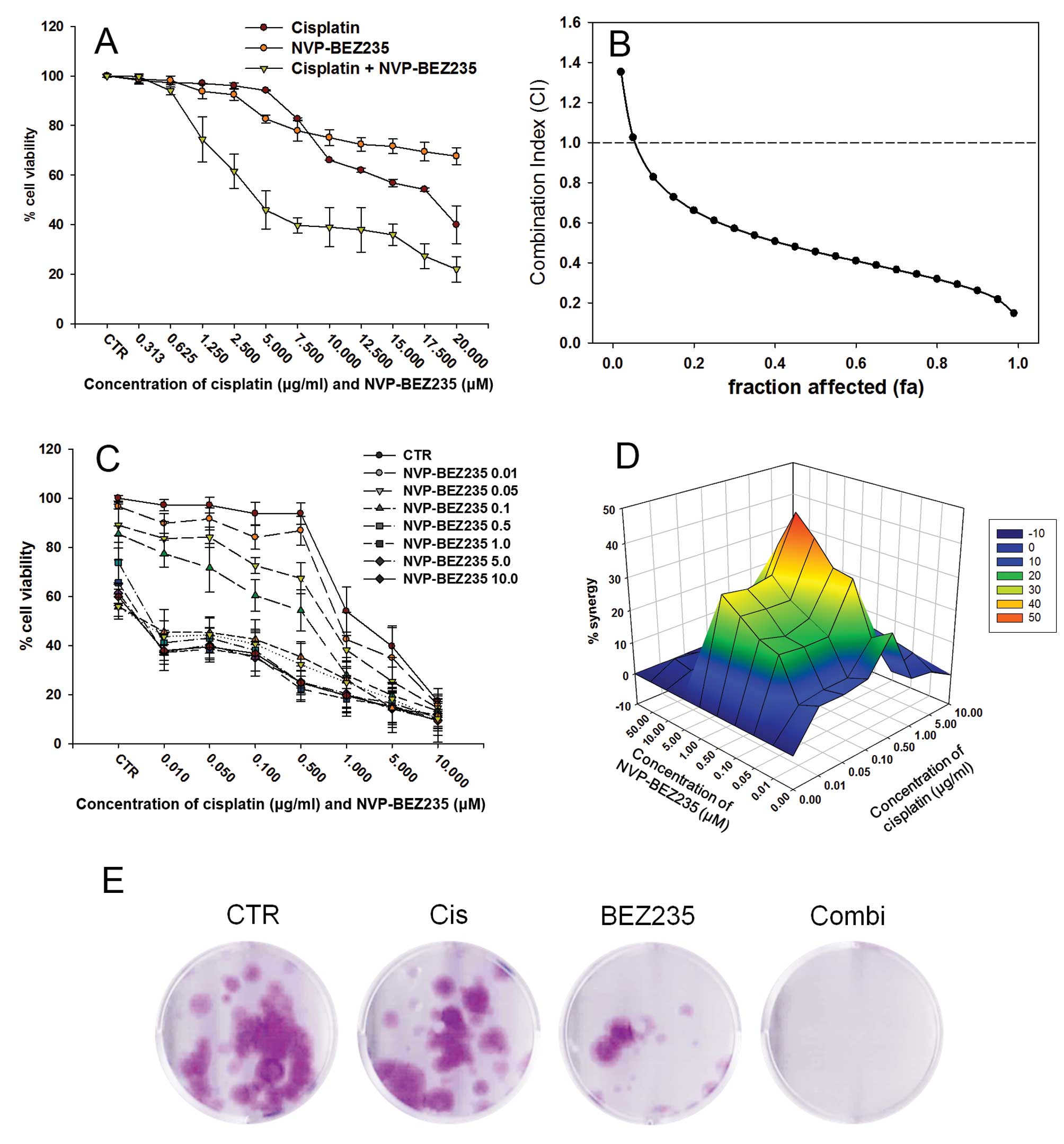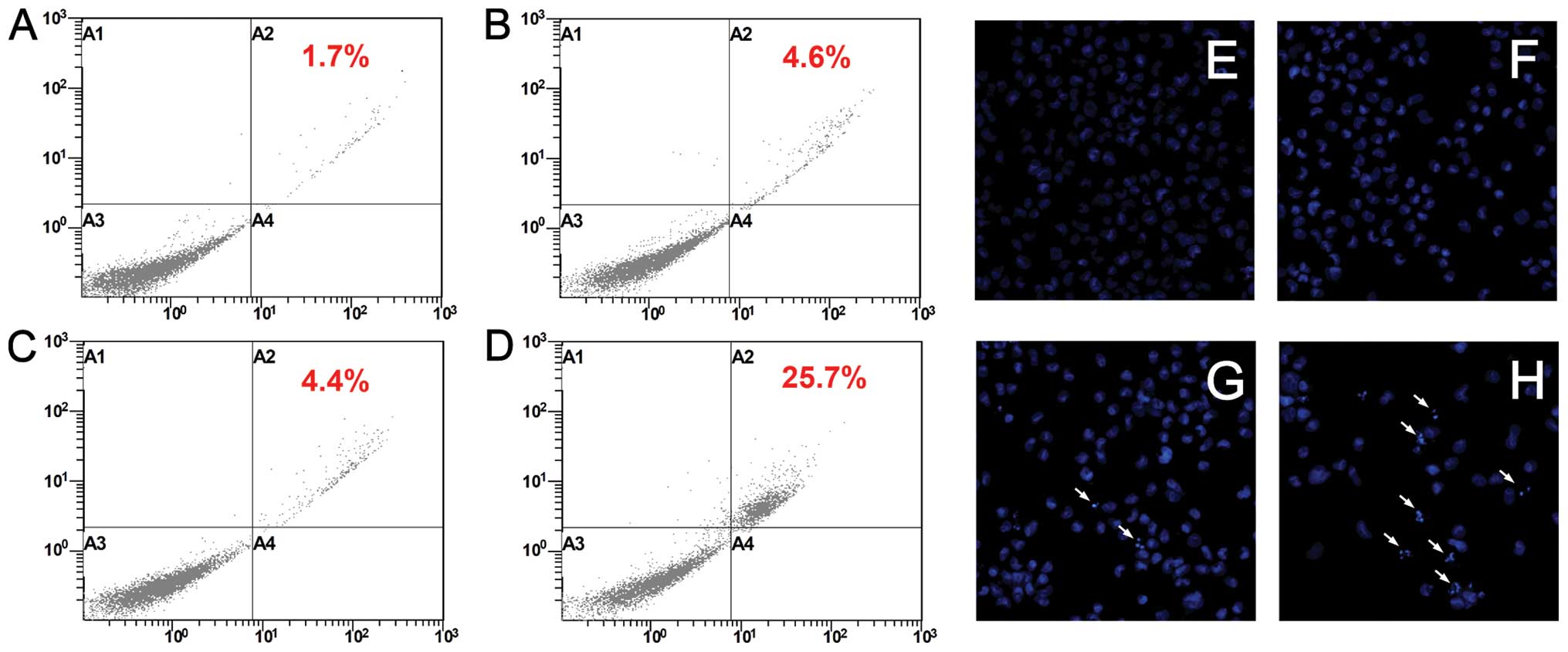|
1
|
Fossa SD, Aass N, Ous S, et al: Survival
after curative treatment of muscle-invasive bladder cancer. Acta
Oncol. 35(Suppl 8): 59–65. 1996. View Article : Google Scholar : PubMed/NCBI
|
|
2
|
Saxman SB, Propert KJ, Einhorn LH, et al:
Long-term follow-up of a phase III intergroup study of cisplatin
alone or in combination with methotrexate, vinblastine, and
doxorubicin in patients with metastatic urothelial carcinoma: a
cooperative group study. J Clin Oncol. 15:2564–2569. 1997.
|
|
3
|
Hoda MA, Mohamed A, Ghanim B, et al:
Temsirolimus inhibits malignant pleural mesothelioma growth in
vitro and in vivo: synergism with chemotherapy. J Thorac Oncol.
6:852–863. 2011. View Article : Google Scholar : PubMed/NCBI
|
|
4
|
O’Reilly T, McSheehy PM, Wartmann M, et
al: Evaluation of the mTOR inhibitor, everolimus, in combination
with cytotoxic antitumor agents using human tumor models in vitro
and in vivo. Anticancer Drugs. 22:58–78. 2011.PubMed/NCBI
|
|
5
|
Chen P, Wang L, Liu B, et al:
EGFR-targeted therapies combined with chemotherapy for treating
advanced non-small-cell lung cancer: a meta-analysis. Eur J Clin
Pharmacol. 67:235–243. 2011. View Article : Google Scholar : PubMed/NCBI
|
|
6
|
Pinto-Leite R, Botelho P, Ribeiro E, et
al: Effect of sirolimus on urinary bladder cancer T24 cell line. J
Exp Clin Cancer Res. 28:32009. View Article : Google Scholar : PubMed/NCBI
|
|
7
|
Wu X, Obata T, Khan Q, et al: The
phosphatidylinositol-3 kinase pathway regulates bladder cancer cell
invasion. BJU Int. 93:143–150. 2004. View Article : Google Scholar : PubMed/NCBI
|
|
8
|
Puzio-Kuter AM, Castillo-Martin M, Kinkade
CW, et al: Inactivation of p53 and Pten promotes invasive bladder
cancer. Genes Dev. 23:675–680. 2009. View Article : Google Scholar : PubMed/NCBI
|
|
9
|
Garcia JA and Danielpour D: Mammalian
target of rapamycin inhibition as a therapeutic strategy in the
management of urologic malignancies. Mol Cancer Ther. 7:1347–1354.
2008. View Article : Google Scholar : PubMed/NCBI
|
|
10
|
Thallinger C, Poeppl W, Pratscher B, et
al: CCI-779 plus cisplatin is highly effective against human
melanoma in a SCID mouse xenotranplantation model. Pharmacology.
79:207–213. 2007. View Article : Google Scholar
|
|
11
|
Ma BB, Lui VW, Hui EP, et al: The activity
of mTOR inhibitor RAD001 (everolimus) in nasopharyngeal carcinoma
and cisplatin-resistant cell lines. Invest New Drugs. 28:413–420.
2010. View Article : Google Scholar
|
|
12
|
Yardley DA: Combining mTOR inhibitors with
chemotherapy and other targeted therapies in advanced breast
cancer: rationale, clinical experience, and future directions.
Breast Cancer. 7:7–22. 2013.
|
|
13
|
Chiong E, Lee IL, Dadbin A, et al: Effects
of mTOR inhibitor everolimus (RAD001) on bladder cancer cells. Clin
Cancer Res. 17:2863–2873. 2011. View Article : Google Scholar : PubMed/NCBI
|
|
14
|
Fechner G, Classen K, Schmidt D, et al:
Rapamycin inhibits in vitro growth and release of angiogenetic
factors in human bladder cancer. Urology. 73:665–669. 2009.
View Article : Google Scholar : PubMed/NCBI
|
|
15
|
Wu C, Wangpaichitr M, Feun L, et al:
Overcoming cisplatin resistance by mTOR inhibitor in lung cancer.
Mol Cancer. 4:252005. View Article : Google Scholar : PubMed/NCBI
|
|
16
|
Manara MC, Nicoletti G, Zambelli D, et al:
NVP-BEZ235 as a new therapeutic option for sarcomas. Clin Cancer
Res. 16:530–540. 2010. View Article : Google Scholar : PubMed/NCBI
|
|
17
|
Mukherjee B, Tomimatsu N, Amancherla K, et
al: The dual PI3K/mTOR inhibitor NVP-BEZ235 is a potent inhibitor
of ATM- and DNA-PKCs-mediated DNA damage responses. Neoplasia.
14:34–43. 2012.PubMed/NCBI
|
|
18
|
Chou TC and Talalay P: Quantitative
analysis of dose-effect relationships: the combined effects of
multiple drugs or enzyme inhibitors. Adv Enzyme Regul. 22:27–55.
1984. View Article : Google Scholar : PubMed/NCBI
|
|
19
|
Buckwold VE, Wei J, Wenzel-Mathers M, et
al: Synergistic in vitro interactions between alpha interferon and
ribavirin against bovine viral diarrhea virus and yellow fever
virus as surrogate models of hepatitis C virus replication.
Antimicrob Agents Chemother. 47:2293–2298. 2003. View Article : Google Scholar
|
|
20
|
Tarbet EB, Maekawa M, Furuta Y, et al:
Combinations of favipiravir and peramivir for the treatment of
pandemic influenza A/California/04/2009 (H1N1) virus infections in
mice. Antiviral Res. 94:103–110. 2012. View Article : Google Scholar : PubMed/NCBI
|
|
21
|
Vilhelmova N, Jacquet R, Quideau S, et al:
Three-dimensional analysis of combination effect of ellagitannins
and acyclovir on herpes simplex virus types 1 and 2. Antiviral Res.
89:174–181. 2011. View Article : Google Scholar : PubMed/NCBI
|
|
22
|
Lee S, Choi EJ, Jin C, et al: Activation
of PI3K/Akt pathway by PTEN reduction and PIK3CA mRNA amplification
contributes to cisplatin resistance in an ovarian cancer cell line.
Gynecol Oncol. 97:26–34. 2005. View Article : Google Scholar
|
|
23
|
Altomare DA, Wang HQ, Skele KL, et al: AKT
and mTOR phosphorylation is frequently detected in ovarian cancer
and can be targeted to disrupt ovarian tumor cell growth. Oncogene.
23:5853–5857. 2004. View Article : Google Scholar : PubMed/NCBI
|
|
24
|
Fahy BN, Schlieman MG, Virudachalam S, et
al: Inhibition of AKT abrogates chemotherapy-induced NF-kappaB
survival mechanisms: implications for therapy in pancreatic cancer.
J Am Coll Surg. 198:591–599. 2004. View Article : Google Scholar : PubMed/NCBI
|
|
25
|
Zhang HY, Zhang PN and Sun H: Aberration
of the PI3K/AKT/mTOR signaling in epithelial ovarian cancer and its
implication in cisplatin-based chemotherapy. Eur J Obstet Gynecol
Reprod Biol. 146:81–86. 2009. View Article : Google Scholar : PubMed/NCBI
|
|
26
|
Sun CH, Chang YH and Pan CC: Activation of
the PI3K/Akt/mTOR pathway correlates with tumour progression and
reduced survival in patients with urothelial carcinoma of the
urinary bladder. Histopathology. 58:1054–1063. 2011. View Article : Google Scholar : PubMed/NCBI
|
|
27
|
Rao YK, Wu AT, Geethangili M, et al:
Identification of antrocin from Antrodia camphorata as a selective
and novel class of small molecule inhibitor of Akt/mTOR signaling
in metastatic breast cancer MDA-MB-231 cells. Chem Res Toxicol.
24:238–245. 2011. View Article : Google Scholar : PubMed/NCBI
|
|
28
|
Wangpaichitr M, Wu C, You M, et al:
Inhibition of mTOR restores cisplatin sensitivity through
down-regulation of growth and anti-apoptotic proteins. Eur J
Pharmacol. 591:124–127. 2008. View Article : Google Scholar : PubMed/NCBI
|
|
29
|
Mabuchi S, Kawase C, Altomare DA, et al:
mTOR is a promising therapeutic target both in cisplatin-sensitive
and cisplatin-resistant clear cell carcinoma of the ovary. Clin
Cancer Res. 15:5404–5413. 2009. View Article : Google Scholar : PubMed/NCBI
|
|
30
|
Yasumizu Y, Miyajima A, Kosaka T, et al:
Dual PI3K/mTOR inhibitor NVP-BEZ235 sensitizes docetaxel in
castration resistant prostate cancer. J Urol. 191:227–234. 2014.
View Article : Google Scholar : PubMed/NCBI
|
|
31
|
Mansure JJ, Nassim R, Chevalier S, et al:
Inhibition of mammalian target of rapamycin as a therapeutic
strategy in the management of bladder cancer. Cancer Biol Ther.
8:2339–2347. 2009. View Article : Google Scholar : PubMed/NCBI
|
|
32
|
Yang F, Qian XJ, Qin W, et al: Dual
phosphoinositide 3-kinase/mammalian target of rapamycin inhibitor
NVP-BEZ235 has a therapeutic potential and sensitizes cisplatin in
nasopharyngeal carcinoma. PLoS One. 8:e598792013. View Article : Google Scholar : PubMed/NCBI
|
|
33
|
Schult C, Dahlhaus M, Glass A, et al: The
dual kinase inhibitor NVP-BEZ235 in combination with cytotoxic
drugs exerts anti-proliferative activity towards acute
lymphoblastic leukemia cells. Anticancer Res. 32:463–474. 2012.
|
|
34
|
Bhatt AP, Bhende PM, Sin SH, et al: Dual
inhibition of PI3K and mTOR inhibits autocrine and paracrine
proliferative loops in PI3K/Akt/mTOR-addicted lymphomas. Blood.
115:4455–4463. 2010. View Article : Google Scholar : PubMed/NCBI
|
|
35
|
Roccaro AM, Sacco A, Husu EN, et al: Dual
targeting of the PI3K/Akt/mTOR pathway as an antitumor strategy in
Waldenstrom macroglobulinemia. Blood. 115:559–569. 2010. View Article : Google Scholar : PubMed/NCBI
|
|
36
|
Winter JN, Fox TE, Kester M, et al:
Phosphatidic acid mediates activation of mTORC1 through the ERK
signaling pathway. Am J Physiol Cell Physiol. 299:C335–C344. 2010.
View Article : Google Scholar : PubMed/NCBI
|
|
37
|
Zitzmann K, Ruden J, Brand S, et al:
Compensatory activation of Akt in response to mTOR and Raf
inhibitors - a rationale for dual-targeted therapy approaches in
neuroendocrine tumor disease. Cancer Lett. 295:100–109. 2010.
View Article : Google Scholar
|
|
38
|
Aziz SA, Jilaveanu LB, Zito C, et al:
Vertical targeting of the phosphatidylinositol-3 kinase pathway as
a strategy for treating melanoma. Clin Cancer Res. 16:6029–6039.
2010. View Article : Google Scholar : PubMed/NCBI
|
|
39
|
Haagensen EJ, Kyle S, Beale GS, et al: The
synergistic interaction of MEK and PI3K inhibitors is modulated by
mTOR inhibition. Br J Cancer. 106:1386–1394. 2012. View Article : Google Scholar : PubMed/NCBI
|


















